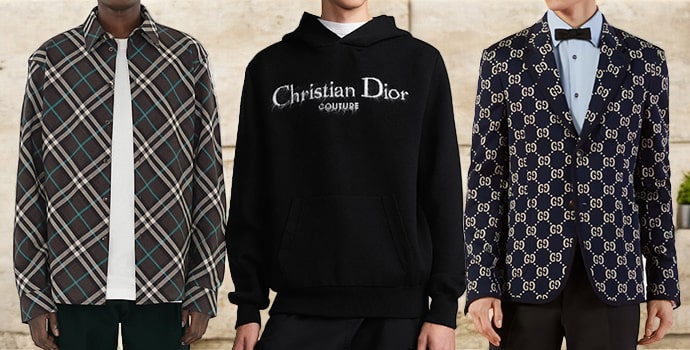Understanding Fabric Weaves and Textures in Branded Clothing
Understanding Fabric Weaves and Textures in Branded Clothing
Blog Article
Recognizing Garments: The Importance of Textile Selections in Your Closet
The choice of material in apparel plays an essential function in both visual appeals and functionality. Different materials offer differing levels of convenience, durability, and breathability, directly influencing the wearer's experience. Recognizing these subtleties can improve one's wardrobe substantially. Yet, numerous forget exactly how these options can influence not simply individual design, however likewise sustainability. What fabric decisions could redefine your wardrobe and straighten it with both design and duty?
The Duty of Textile in vogue and Performance

Common Material Kinds and Their Attributes
When picking apparel, comprehending the features of typical textile types is important for making informed options. Cotton, a widely-used natural fiber, is known for its breathability, softness, and convenience, making it ideal for informal wear and daily garments. Linen, an additional natural alternative, flaunts exceptional moisture-wicking homes and a distinct structure, ideal for cozy climates.Wool, frequently preferred for its heat and sturdiness, varies in fineness; merino wool is soft against the skin, while coarser kinds are made use of for outerwear. Synthetic materials like polyester and nylon provide sturdiness and resistance to creases, making them prominent for activewear and travel garments. Blends, which combine natural and synthetic fibers, can enhance performance while maintaining convenience. By identifying these textile attributes, individuals can select clothing that straightens with their way of living and visual choices.
Breathability and Comfort: Choosing the Right Fabrics for Various Environments
Choosing the ideal textiles for different climates can considerably boost convenience and general wearability. Breathable materials are vital in warm environments, as they enable air circulation and moisture dissipation. Fabrics such as cotton, bed linen, and moisture-wicking synthetics properly attract sweat far from the body, maintaining the wearer cool and dry. Alternatively, in chillier environments, thicker textiles like woollen or fleece supply insulation while keeping breathability, guaranteeing warmth without overheating.Additionally, the option of fabric weight plays an important role; lightweight materials are preferable for summer, whereas much heavier choices are suited for winter months wear. Comprehending the distinct buildings of each fabric enables individuals to dress appropriately for varying climate condition. Ultimately, selecting comfortable and breathable textiles customized to details climates can significantly enhance daily convenience and improve the overall experience of using garments.
Sturdiness and Care: Exactly How Material Influences Durability of Your Closet
Selecting the appropriate materials can substantially influence the sturdiness and treatment requirements of a closet. Fabrics such as cotton and polyester are recognized for their strength and ease of upkeep, making them perfect for daily wear. In comparison, delicate materials like silk and lace need even more mindful handling and specialized cleaning techniques, which can boost the time and effort required for care. Branded Clothing.Durability is also influenced by the fabric's weave and coating; securely woven materials have a tendency to resist deterioration much better than freely woven alternatives. In addition, artificial blends frequently offer enhanced toughness, integrating the very best top qualities of several fibers.Understanding the treatment guidelines for every textile is important, as inappropriate drying out or washing can cause premature wear. Ultimately, picking resilient materials can lead to a longer-lasting closet, reducing the frequency of substitutes and adding to a much more lasting fashion option
The Influence of Fabric on Fit and Silhouette

Lasting Material Choices: Making Eco-Friendly Choices
The impact of textile prolongs beyond fit and silhouette to include environmental elements, prompting a growing interest in lasting material options. Environment-friendly textiles, such as organic cotton, hemp, and Tencel, are gaining traction among consumers who focus on sustainability in their closets. These products are usually generated with fewer chemicals and water, decreasing their ecological footprint.Additionally, recycled materials, made from post-consumer waste, supply a cutting-edge solution to the textile industry's pollution problem. Brands progressively accept transparency in their sourcing techniques, allowing customers to make enlightened choices regarding their purchases.Choosing lasting fabrics not just sustains ethical methods but also urges the apparel industry to take on more liable production techniques. As recognition of ecological issues climbs, individuals are prompted to review the long-term effect of their fabric options, fostering a motion towards a more ecologically aware and lasting approach to style.
Elevating Design: Just How Textile Can Change an Attire
While lots of might focus on color and cut when picking an attire, the choice of textile plays a crucial function in elevating style and improving general appearance. Different products share distinct state of minds and messages; for instance, silk shows deluxe and class, while jeans supplies a laid-back, unwinded ambiance. The structure and drape of a material can considerably modify the silhouette, with organized materials offering a refined appearance and softer ones developing a much more fluid, relaxed aesthetic.Moreover, the weight of the textile influences wearability throughout periods. Lightweight fabrics like bed linen and cotton are suitable for summertime, while heavier materials such as woollen and velvet give warmth and style in chillier months. Comprehending fabric homes, such as breathability and stretch, likewise empowers people to make informed choices that boost convenience without jeopardizing style. Inevitably, the appropriate material can change an outfit from average to amazing, making it a crucial factor to consider in any type of closet.
Often Asked Questions
How Do I Identify the Material Web Content of My Apparel?
To identify material web content, one can examine care tags, conduct melt tests for fiber identification, or seek advice from textile examples. These methods help distinguish materials, making sure educated options for apparel care and maintenance in day-to-day wear.
Can Textile Option Affect My Mood or Self-confidence?
Fabric selection can significantly influence an individual's mood and confidence. Branded Clothing. Certain products may evoke feelings of comfort or style, while others can really feel unflattering or restrictive, ultimately affecting self-perception and emotional health throughout the day
What Fabrics Are Ideal for Sensitive Skin?
For individuals with sensitive skin, all-natural textiles like bamboo, linen, and cotton are usually suggested. These materials are breathable, hypoallergenic, and less most likely to cause inflammation, making them suitable options for comfort and skin wellness.
How Do I Appropriately Laundry and Care for Various Fabrics?
To appropriately care and clean for various fabrics, one must take into consideration each material's details needs, including temperature setups, cleaning agents, and drying out methods, making sure durability and maintaining the fabric's original top qualities for perfect use.
Exist Certain Fabrics for Athletic or Performance Use?
Athletic or performance wear frequently makes Home Page use of textiles such as spandex, polyester, and nylon. These products are designed for moisture-wicking, breathability, and flexibility, enhancing activity and comfort throughout exercises while providing resilience and support. Conversely, in chillier climates, thicker textiles like wool or fleece give insulation while retaining breathability, making sure heat without overheating.Additionally, the selection of fabric weight plays a crucial duty; light-weight textiles are better for summer, whereas heavier choices are suited for winter season wear. In comparison, fragile materials like silk and shoelace require even more cautious handling and specialized cleaning techniques, Click Here which can enhance the time and initiative required for care.Durability is additionally affected by the fabric's weave and coating; securely woven fabrics have a tendency to resist wear and tear better than loosely woven options. In comparison, rigid textiles can restrict motion however provide a timeless, refined look.Moreover, the density and appearance of the fabric can affect the aesthetic assumption of body form. The effect of textile extends past fit and silhouette to incorporate environmental factors, triggering a growing rate of interest in sustainable material choices. The structure and drape of a material can significantly modify the silhouette, with organized textiles offering a refined look and softer ones developing a more fluid, kicked back aesthetic.Moreover, the weight of the material affects wearability across periods.
Report this page